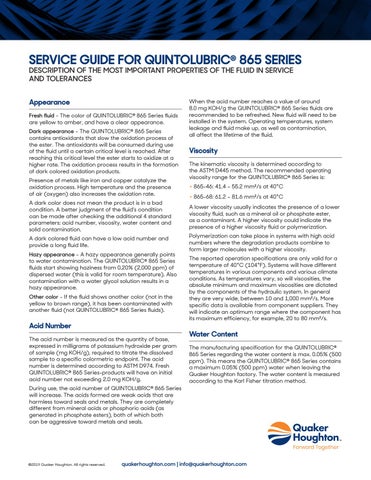SERVICE GUIDE FOR QUINTOLUBRIC® 865 SERIES DESCRIPTION OF THE MOST IMPORTANT PROPERTIES OF THE FLUID IN SERVICE AND TOLERANCES Appearance Fresh fluid - The color of QUINTOLUBRIC® 865 Series fluids are yellow to amber, and have a clear appearance. Dark appearance - The QUINTOLUBRIC® 865 Series contains antioxidants that slow the oxidation process of the ester. The antioxidants will be consumed during use of the fluid until a certain critical level is reached. After reaching this critical level the ester starts to oxidize at a higher rate. The oxidation process results in the formation of dark colored oxidation products. Presence of metals like iron and copper catalyze the oxidation process. High temperature and the presence of air (oxygen) also increases the oxidation rate. A dark color does not mean the product is in a bad condition. A better judgment of the fluid’s condition can be made after checking the additional 4 standard parameters: acid number, viscosity, water content and solid contamination. A dark colored fluid can have a low acid number and provide a long fluid life. Hazy appearance - A hazy appearance generally points to water contamination. The QUINTOLUBRIC® 865 Series fluids start showing haziness from 0.20% (2,000 ppm) of dispersed water (this is valid for room temperature). Also contamination with a water glycol solution results in a hazy appearance. Other color - If the fluid shows another color (not in the yellow to brown range), it has been contaminated with another fluid (not QUINTOLUBRIC® 865 Series fluids).
Acid Number The acid number is measured as the quantity of base, expressed in milligrams of potassium hydroxide per gram of sample (mg KOH/g), required to titrate the dissolved sample to a specific colormetric endpoint. The acid number is determined according to ASTM D974. Fresh QUINTOLUBRIC® 865 Series-products will have an initial acid number not exceeding 2.0 mg KOH/g. During use, the acid number of QUINTOLUBRIC® 865 Series will increase. The acids formed are weak acids that are harmless toward seals and metals. They are completely different from mineral acids or phosphoric acids (as generated in phosphate esters), both of which both can be aggressive toward metals and seals.
©2019 Quaker Houghton. All rights reserved.
When the acid number reaches a value of around 8.0 mg KOH/g the QUINTOLUBRIC® 865 Series fluids are recommended to be refreshed. New fluid will need to be installed in the system. Operating temperatures, system leakage and fluid make up, as well as contamination, all affect the lifetime of the fluid.
Viscosity The kinematic viscosity is determined according to the ASTM D445 method. The recommended operating viscosity range for the QUINTOLUBRIC® 865 Series is:
• 865-46: 41.4 – 55.2 mm²/s at 40°C • 865-68: 61.2 – 81.6 mm²/s at 40°C
A lower viscosity usually indicates the presence of a lower viscosity fluid, such as a mineral oil or phosphate ester, as a contaminant. A higher viscosity could indicate the presence of a higher viscosity fluid or polymerization. Polymerization can take place in systems with high acid numbers where the degradation products combine to form larger molecules with a higher viscosity. The reported operation specifications are only valid for a temperature of 40°C (104°F). Systems will have different temperatures in various components and various climate conditions. As temperatures vary, so will viscosities, the absolute minimum and maximum viscosities are dictated by the components of the hydraulic system. In general they are very wide, between 10 and 1,000 mm²/s. More specific data is available from component suppliers. They will indicate an optimum range where the component has its maximum efficiency, for example, 20 to 80 mm²/s.
Water Content The manufacturing specification for the QUINTOLUBRIC® 865 Series regarding the water content is max. 0.05% (500 ppm). This means the QUINTOLUBRIC® 865 Series contains a maximum 0.05% (500 ppm) water when leaving the Quaker Houghton factory. The water content is measured according to the Karl Fisher titration method.
quakerhoughton.com | info@quakerhoughton.com
